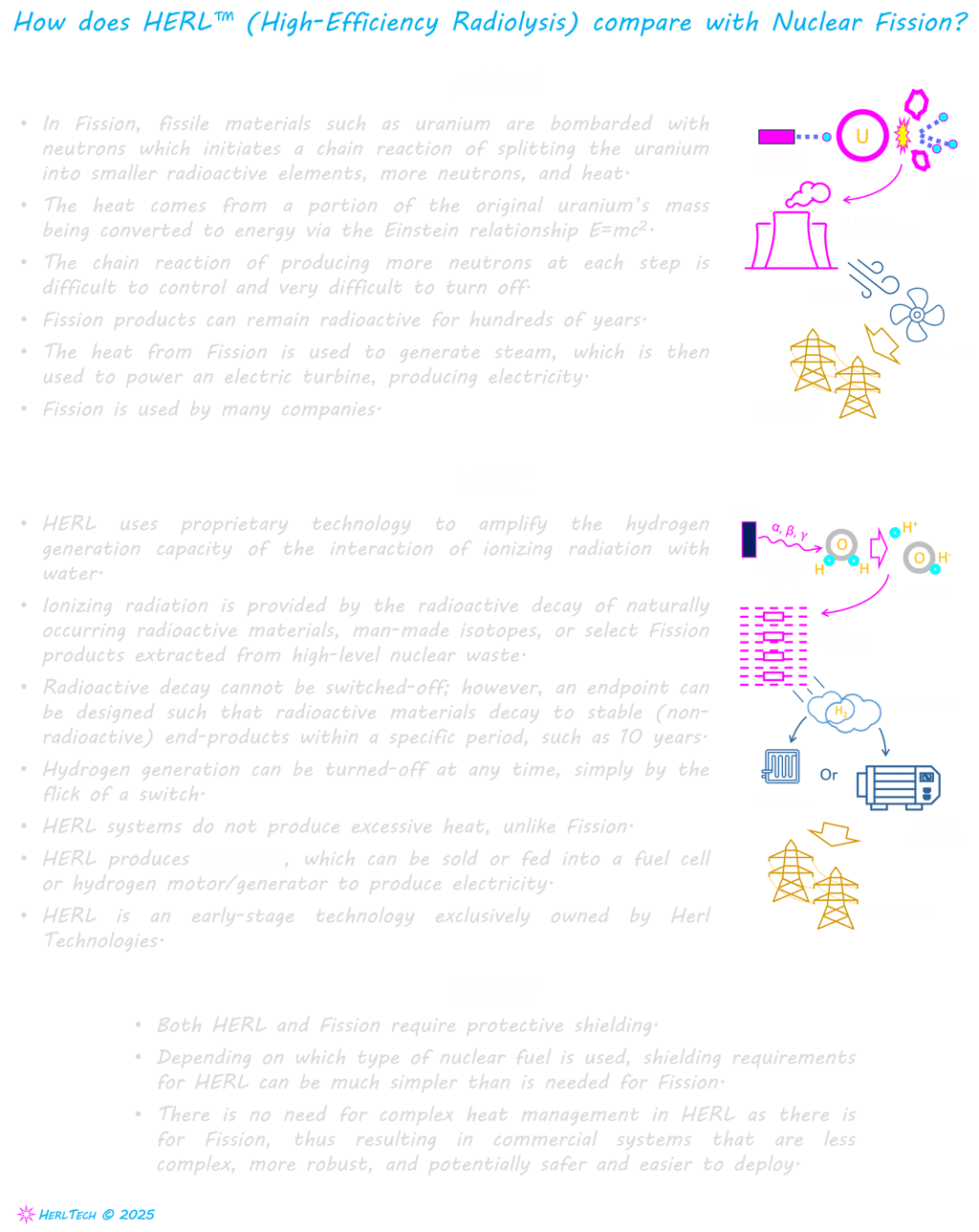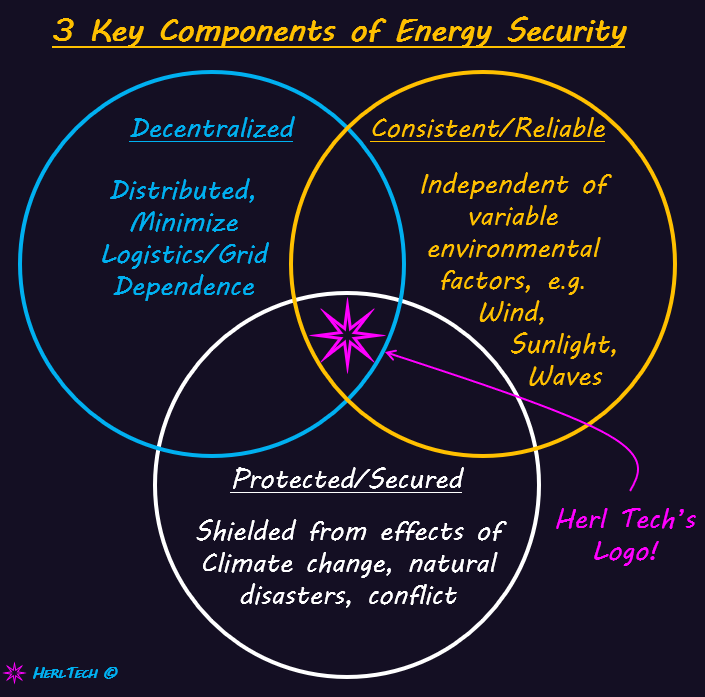High-Efficiency Radiolysis: Nuclear Hydrogen
HERL Technologies




[ Please check download folder after clicking above ]
We are solving problems of power scarcity, consistency, and energy security by developing a new “kinder & gentler” form of nuclear power with the potential of being safer and easier to deploy than fission, fusion or nuclear batteries. It also has the benefit of producing hydrogen because we are splitting water using atomic energy rather than boiling it.
Traditionally the term nuclear hydrogen has been associated with the use of either excess heat energy created at nuclear power plants (NPP) to facilitate the production of hydrogen by various methods (purple & red hydrogen on the color spectrum), or the use of electricity produced at NPP to power traditional electrolysis (pink hydrogen).
Herl Tech, on the other hand, is developing an entirely new method of producing hydrogen, based not on excess heat or electricity from NPP, but on the actual interaction of ionizing radiation with water, also called radiolysis. As a matter of fact, all NPP already produce small amounts of hydrogen this way, but they do it very inefficiently and the hydrogen they produce is considered a nuisance byproduct. However, over the last couple of decades researchers have identified processes that actually amplify hydrogen generation by radiolysis. Herl Tech is leveraging these developments, in addition to contributing our own revolutionary designs and discoveries, to develop a new, patent pending method of amplifying hydrogen production to commercially viable levels using a method we call High-Efficiency Radiolysis, or HERL™ Technology. No fission or fusion required!
What is Nuclear Hydrogen?
How will Herl Technologies “Solve” the Challenges of Hydrogen Transportation & Storage?
Technical challenges associated with hydrogen transportation and storage remain significant hurdles in achieving a successful hydrogen economy. Herl Tech’s “solution” is to make them, for the most part, no longer relevant.
What?!?!
To understand this explanation, we need to understand why the problem of hydrogen transportation and storage, on a large scale, exist in the first place. While there will likely always be the need for ‘last mile’ transportation, and storage needs associated with weight- or size-sensitive applications, such as mobility, in large part the challenges of hydrogen transportation and storage stem from and are exacerbated by the Net Negative power problem associated with current methods of hydrogen production.
As is well understood in the energy industry, it takes more power to produce a kg of hydrogen than is recovered from it, when utilized. This is the Net Negative power problem (among other names). Examples of 50kWh to produce 1kg compared to 40kWh recovered from 1kg, are sometimes given. One of the many distortions this causes in the hydrogen industry is, due to the economic benefits of scale, there is substantial motivation to make hydrogen production systems as large as possible, perhaps hundreds or thousands of times more production capacity than is needed locally in the region surrounding the production plant. This leads to the need to store and transport the hydrogen to where it is required, even thousands of kilometers away.
Now, imagine it took 20kWh of power to produce 1kg of hydrogen, compared to the current 50kWh, but the same 40kWh is recovered. This is Net Positive in power generation, which is the case with other energy sources, such as oil or solar or wind. Also, imagine there were no specific benefit to scale, in fact the opposite could be the case (smaller is better). Imagine further that hydrogen production could be co-located with the industrial complex or community it is supplying. Finally, imagine, due to being Net Positive in power generation, the majority of hydrogen being produced with this new method is directly coupled to fuel cells or hydrogen ICE/generators and immediately converted to electricity. There are far more solutions available for electricity transport and storage than hydrogen transport and storage.
Under these conditions, the challenges of transport and storage of hydrogen are largely resolved. Undoubtedly other challenges arise with this new technology, once it is mature, and they certainly exist in its current state, but Herl Technologies proposes that the development of High-Efficiency Radiolysis (HERL) to produce Nuclear Hydrogen, not only serves to resolve many challenges associated with Nuclear Power, but has the potential of allowing the Hydrogen Economy to achieve is long-sought-for position at the pinnacle of Zero Carbon energy.
Why Has No One Used Radiolysis to Produce Hydrogen Before?
Herl Technologies is the only company, that we are aware of, proposing the cost and energy efficient production of hydrogen using a process called high-efficiency radiolysis (HERL™), which uses atomic energy to split water to produce hydrogen, rather than electrolysis. We have proprietary technology that, for the first time, can make this feasible at a commercial scale.
As mentioned in a previous post, all operating nuclear power plants produce a small amount of hydrogen through radiolysis, but they do it very inefficiently. However, over the last couple of decades researchers have observed ways to amplify hydrogen generation by radiolysis, specifically by the interaction of ionizing radiation with water in the presence of an electric field (1) (2), also called Radioelectrolysis, and the interaction of ionizing radiation with water in the presence of certain metal oxides (3), also called Radiation Catalysts.
There have been multiple reasons ‘experts’ have told us, that HERL technology will not work. Some of these ‘experts’ have even already tried to produce hydrogen by radiolysis, or they just cite past work by others who have tried it. Two of the reasons mentioned include:
1. The co-generation of oxygen and hydrogen at the same location makes separation difficult, representing a significant technical hurdle.
The mechanism of Radioelectrolysis is ignored by this concern. Before molecular hydrogen and oxygen gases are formed, their pre-cursor ions are formed. These ions are immediately separated by an applied electric field and driven apart to separate and distinct oxygen and hydrogen ion-to-gas conversion (REDOX) and collection regions, such that the co-formation of these gases at the point of interaction of water with radiation is greatly reduced or eliminated.
2. Too much radiation is needed to generate enough hydrogen to be commercially viable.
The perceived need of high radiation does not consider the radiation amplification capacity of Radioelectrolysis and Radiation Catalysts. With these 2 factors combined, together with Herl Tech’s own proprietary technology and designs, it is anticipated that the amount of radiation needed to produce a given amount of hydrogen will be reduced by multiple orders of magnitude compared to currently perceived values.
Given that ‘experts’ dismiss HERL due to demonstrably inaccurate reasons, it is easy to conclude that these individuals are not aware of these developments, even though they are available in scientific literature. I welcome any reader trained in nuclear research, radiochemistry, or similar field, to comment on this post as to whether they are familiar with these two concepts.
So, why has HERL not been developed until now? Because the principles of Radiation Catalysts and Radioelectrolysis are not known or not understood. However, even if these two phenomena are taken into consideration, it is not until the revolutionary designs and discoveries made by Herl Technologies are combined with these findings, does HERL and Nuclear Hydrogen become a commercial possibility.
(1) Saji, G. (2016), Root cause study on hydrogen generation and explosion through radiation-induced electrolysis in the Fukushima Daiichi accident, Nuclear Engineering and Design, Vol 307, 64-76, ISSN 0029-5493, https://doi.org/10.1016/j.nucengdes.2016.01.039.
(2) Saji, G. (2017), Radiation-induced electrolytic phenomena with differential radiation cell in water-cooled nuclear reactors, Nuclear Engineering and Design, Vol 320, 452-480,ISSN 0029-5493, https://doi.org/10.1016/j.nucengdes.2017.03.022.
(3) Le Caër, S. (2011). Water Radiolysis: Influence of Oxide Surfaces on H2 Production under Ionizing Radiation. Water, 3(1), 235-253. DOI: 10.3390/w3010235
How does Nuclear Hydrogen Compare with Pink Hydrogen?
Nuclear Hydrogen is the name associated with the production of hydrogen using the process of High-Efficiency Radiolysis (HERL) (please see previous posts for more details).
Pink or Purple Hydrogen is the color associated with hydrogen production by electrolysis, but where the electricity for powering the electrolysis comes from a nuclear power plant (NPP).
Let’s compare the two processes-
Pink Hydrogen:
A quantum process (fission) is used to produce heat.
Heat is used to create steam.
Steam is used to drive a turbine to produce electricity.
Electricity is used to power electrolysis.
Electrolysis produces hydrogen.
Nuclear Hydrogen (HERL):
A quantum process (radiolysis) is used to produce hydrogen.
Is this a fair comparison? Both processes are clearly simplified. Fission is not stand-alone, neither is electrolysis, neither is radiolysis, but I believe the comparison is valid. It seems if hydrogen is your end target, HERL is a more direct path.
Of course, fission and electrolysis are well known, proven processes. HERL is not, yet. We are working on it.
Did I mention other benefits of HERL-
No extreme temperatures (<150°C compared to 1,000°C for fission and 1,000,000°C for fusion)
No positive-feedback loops (fission is difficult to control because of this)
No complex heat management systems
No long-term radioactivity ( ~10 years compared to fission > 100 years)
Message me if you want help accelerate the development of HERL!
How does Herl Tech fit in with the 3 Key Components of Energy Security?

